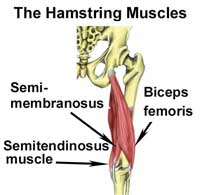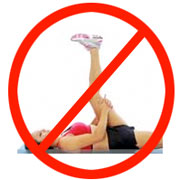Do I really need to stretch my hamstrings?

Upper Crossed Syndrome Causes and Treatment Options
March 22, 2016
Piriformis Syndrome
April 7, 2016 Should I be stretching or strengthening my hamstrings?
Should I be stretching or strengthening my hamstrings?
Hamstring tightness or weakness?
We see many patients complaining of tight or stiff hamstrings who have been prescribed many times over by physical therapists, strength coaches, and friends alike to stretch their hamstrings. Yes, there are times when these stretches are necessary, but there are also many times when they simply aren’t, hamstring stretching isn’t always the best thing to do.
There are two main types of muscle tightness, Neurological and Mechanical tightness.
Neurological tightness occurs when the muscle is consistently lengthened, this triggers a neural input from the brain thought to be a protective response. Essentially, the body is trying to prevent the muscle from being stretched too far, so yo
u experience the sense that the muscle is tight.
In this situation, trying to stretch your hamstrings isn’t going to help the problem. Instead, it will simply further lengthen the tissue. You may experience some relief from stretching, but you aren’t reaching the actual problem and why you feel tight. The relief will only be temporary. Once it passes, you will feel like you need to stretch the hamstrings again, and again.
Mechanical tightness occurs when a muscle is actually shortened, which is most often caused by poor posture or movement.
This is where your hamstrings are actually shortened and they are tight. If this is the case – go ahead and stretch your hamstrings. But remember, until you rectify the root cause for them being tight, you are going to be chasing a never-ending problem.
What next?
Find out why your hamstrings are short. Is it because you’re weak in the front of your hips and your pelvis is posteriorly rotated? Is it because of the position you sit in all day? Until you figure out the why, you’re not going to resolve the issue.
How to tell the difference between Neurological and Mechanical tightness
To get to the root of the problem, you need to be assessed by a Sports Rehabilitation Therapist, movement specialist or Sports Chiropractor. The problem could be due to a number of different factors, but the most common is a mechanical tightness of the hip flexors. If your hip flexors are tight, the pelvis can become tilted forward. Because our hamstrings are attached to the back of the pelvis, this tilting will cause the hamstrings to be maintained in a lengthened position.
This means that instead of stretching the hamstrings, you should actually be working on strengthening them so they can counteract the anterior pelvic tilt position, while also working to mobilise the anterior hip.
Another common problem with “tight hamstrings” is that you are simply not moving properly or using proper motor sequencing. In this situation, muscles aren’t activating and firing at the appropriate time, causing your hamstring to do much of the work other muscles are supposed to do.
For example, when extending the hip, your glutes should fire first, followed by the secondary hamstrings. For many people, the glutes don’t fire properly (in some cases barely at all) and the hamstrings take over the main job of extending the hip. But the hamstrings weren’t designed to be the primary mover here, and they will therefore have to be contracted for longer – giving you the feeling of tightness.
How to Fix Neurological or Mechanical Tightness
Firstly you have to determine why, if it’s a motor sequencing pattern insufficiency or if it’s just simply tight. You could start with rolling out areas around your hamstrings such as hips and quads and seeing if this makes any difference before attacking the hamstrings with endless stretches and mobility. Once you have mobilised and stretched other areas you then have to create a motor pattern or firing pattern in which the glutes and core work together to stabilise the pelvis which in turn will allow the neurological pathways to relax the hamstrings and therefore give you better flexibility and or movement.
Before you spend hours per week stretching your hamstrings, get a quick assessment and find out if in fact you should be stretching – or if you need to be working on something entirely different, like strengthening or motor programming. A Sports Rehabilitation therapist can easily assess and let you know if your muscle is physically shortened or lengthened or if you simply need to move differently. It will save you a lot of time, and prevent you from injuring yourself in the future.
Paul.




